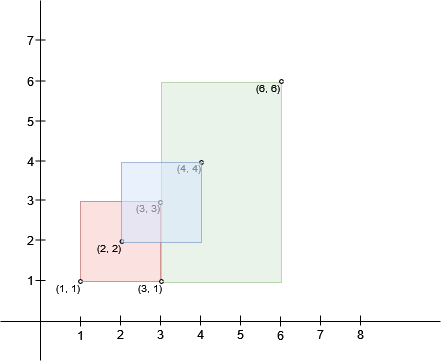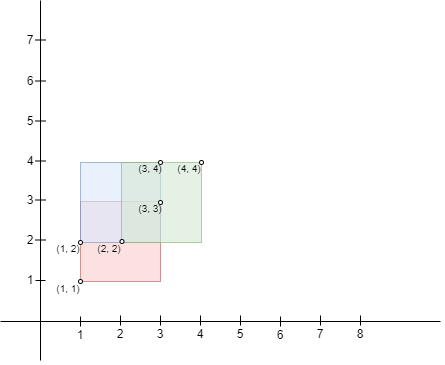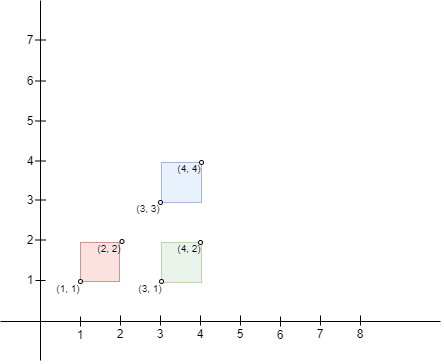| comments | difficulty | edit_url | rating | source | tags | |||
|---|---|---|---|---|---|---|---|---|
true |
中等 |
1601 |
第 386 场周赛 Q2 |
|
在二维平面上存在 n 个矩形。给你两个下标从 0 开始的二维整数数组 bottomLeft 和 topRight,两个数组的大小都是 n x 2 ,其中 bottomLeft[i] 和 topRight[i] 分别代表第 i 个矩形的 左下角 和 右上角 坐标。
我们定义 向右 的方向为 x 轴正半轴(x 坐标增加),向左 的方向为 x 轴负半轴(x 坐标减少)。同样地,定义 向上 的方向为 y 轴正半轴(y 坐标增加),向下 的方向为 y 轴负半轴(y 坐标减少)。
你可以选择一个区域,该区域由两个矩形的 交集 形成。你需要找出能够放入该区域 内 的 最大 正方形面积,并选择最优解。
返回能够放入交集区域的正方形的 最大 可能面积,如果矩形之间不存在任何交集区域,则返回 0。
示例 1:
输入:bottomLeft = [[1,1],[2,2],[3,1]], topRight = [[3,3],[4,4],[6,6]] 输出:1 解释:边长为 1 的正方形可以放入矩形 0 和矩形 1 的交集区域,或矩形 1 和矩形 2 的交集区域。因此最大面积是边长 * 边长,即 1 * 1 = 1。 可以证明,边长更大的正方形无法放入任何交集区域。
示例 2:
输入:bottomLeft = [[1,1],[2,2],[1,2]], topRight = [[3,3],[4,4],[3,4]] 输出:1 解释:边长为 1 的正方形可以放入矩形 0 和矩形 1,矩形 1 和矩形 2,或所有三个矩形的交集区域。因此最大面积是边长 * 边长,即 1 * 1 = 1。 可以证明,边长更大的正方形无法放入任何交集区域。 请注意,区域可以由多于两个矩形的交集构成。
示例 3:
输入:bottomLeft = [[1,1],[3,3],[3,1]], topRight = [[2,2],[4,4],[4,2]] 输出:0 解释:不存在相交的矩形,因此,返回 0 。
提示:
n == bottomLeft.length == topRight.length2 <= n <= 103bottomLeft[i].length == topRight[i].length == 21 <= bottomLeft[i][0], bottomLeft[i][1] <= 1071 <= topRight[i][0], topRight[i][1] <= 107bottomLeft[i][0] < topRight[i][0]bottomLeft[i][1] < topRight[i][1]
我们可以枚举两个矩形,其中矩形
如果矩形
- 左下角横坐标是两个矩形左下角横坐标的最大值,即
$\max(x_1, x_3)$ ; - 左下角纵坐标是两个矩形左下角纵坐标的最大值,即
$\max(y_1, y_3)$ ; - 右上角横坐标是两个矩形右上角横坐标的最小值,即
$\min(x_2, x_4)$ ; - 右上角纵坐标是两个矩形右上角纵坐标的最小值,即
$\min(y_2, y_4)$ 。
那么交集的宽和高分别为
时间复杂度
class Solution:
def largestSquareArea(
self, bottomLeft: List[List[int]], topRight: List[List[int]]
) -> int:
ans = 0
for ((x1, y1), (x2, y2)), ((x3, y3), (x4, y4)) in combinations(
zip(bottomLeft, topRight), 2
):
w = min(x2, x4) - max(x1, x3)
h = min(y2, y4) - max(y1, y3)
e = min(w, h)
if e > 0:
ans = max(ans, e * e)
return ansclass Solution {
public long largestSquareArea(int[][] bottomLeft, int[][] topRight) {
long ans = 0;
for (int i = 0; i < bottomLeft.length; ++i) {
int x1 = bottomLeft[i][0], y1 = bottomLeft[i][1];
int x2 = topRight[i][0], y2 = topRight[i][1];
for (int j = i + 1; j < bottomLeft.length; ++j) {
int x3 = bottomLeft[j][0], y3 = bottomLeft[j][1];
int x4 = topRight[j][0], y4 = topRight[j][1];
int w = Math.min(x2, x4) - Math.max(x1, x3);
int h = Math.min(y2, y4) - Math.max(y1, y3);
int e = Math.min(w, h);
if (e > 0) {
ans = Math.max(ans, 1L * e * e);
}
}
}
return ans;
}
}class Solution {
public:
long long largestSquareArea(vector<vector<int>>& bottomLeft, vector<vector<int>>& topRight) {
long long ans = 0;
for (int i = 0; i < bottomLeft.size(); ++i) {
int x1 = bottomLeft[i][0], y1 = bottomLeft[i][1];
int x2 = topRight[i][0], y2 = topRight[i][1];
for (int j = i + 1; j < bottomLeft.size(); ++j) {
int x3 = bottomLeft[j][0], y3 = bottomLeft[j][1];
int x4 = topRight[j][0], y4 = topRight[j][1];
int w = min(x2, x4) - max(x1, x3);
int h = min(y2, y4) - max(y1, y3);
int e = min(w, h);
if (e > 0) {
ans = max(ans, 1LL * e * e);
}
}
}
return ans;
}
};func largestSquareArea(bottomLeft [][]int, topRight [][]int) (ans int64) {
for i, b1 := range bottomLeft {
t1 := topRight[i]
x1, y1 := b1[0], b1[1]
x2, y2 := t1[0], t1[1]
for j := i + 1; j < len(bottomLeft); j++ {
x3, y3 := bottomLeft[j][0], bottomLeft[j][1]
x4, y4 := topRight[j][0], topRight[j][1]
w := min(x2, x4) - max(x1, x3)
h := min(y2, y4) - max(y1, y3)
e := min(w, h)
if e > 0 {
ans = max(ans, int64(e)*int64(e))
}
}
}
return
}function largestSquareArea(bottomLeft: number[][], topRight: number[][]): number {
let ans = 0;
for (let i = 0; i < bottomLeft.length; ++i) {
const [x1, y1] = bottomLeft[i];
const [x2, y2] = topRight[i];
for (let j = i + 1; j < bottomLeft.length; ++j) {
const [x3, y3] = bottomLeft[j];
const [x4, y4] = topRight[j];
const w = Math.min(x2, x4) - Math.max(x1, x3);
const h = Math.min(y2, y4) - Math.max(y1, y3);
const e = Math.min(w, h);
if (e > 0) {
ans = Math.max(ans, e * e);
}
}
}
return ans;
}

